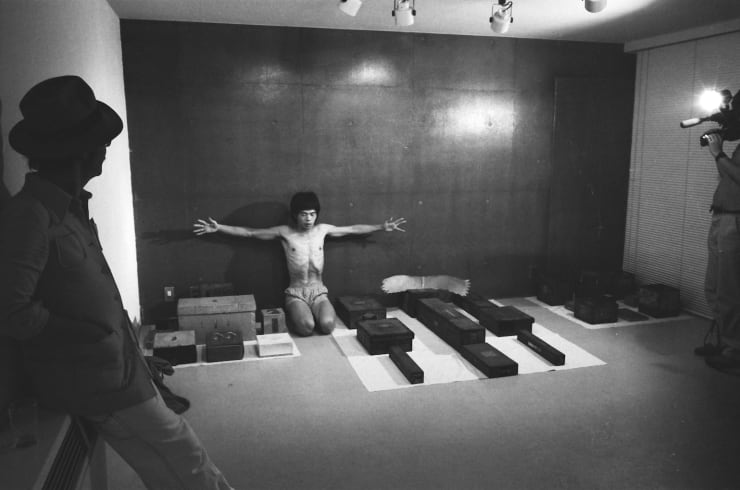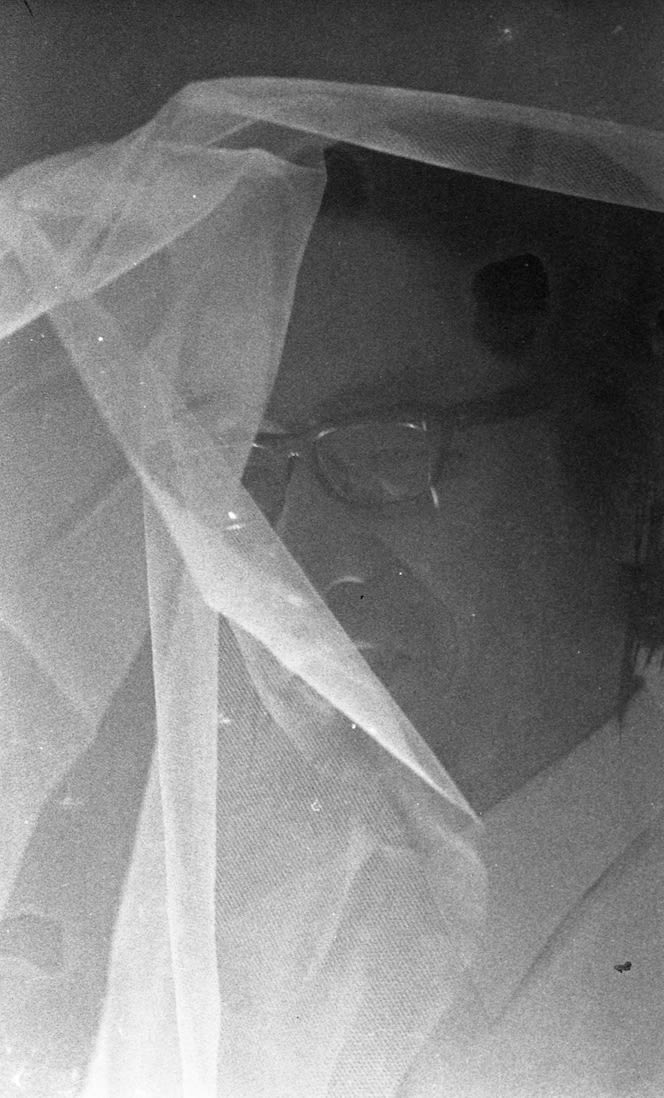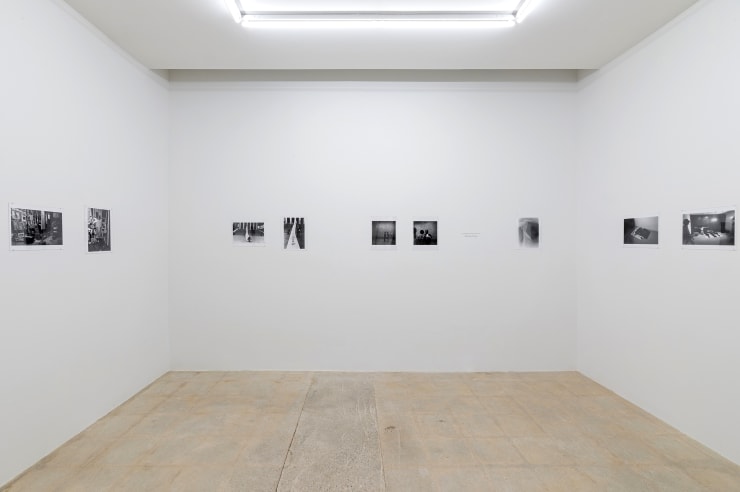Mitsutoshi Hanaga
Mitsutoshi Hanaga (1933–1999) was a Japanese photographer and artist renowned for his extensive documentation of Japan’s postwar avant-garde art, counterculture, and social movements. Born in Otsuka, Tokyo, Hanaga lived through the transformative decades of the 1950s to 1980s, capturing the dynamism and contradictions of a rapidly changing society. His work focused on marginalized communities, avant-garde performances, and social issues, including environmental pollution, student protests, and the Butoh dance movement. Influenced by photographers like Man Ray and László Moholy-Nagy, Hanaga began his career experimenting with photograms and decalcomania before transitioning to photojournalism and documentary photography.
Hanaga’s approach was deeply empathetic, aligning his lens with the underprivileged and rebellious. He documented key figures and collectives such as Hi-Red Center, Yutaka Matsuzawa, Tatsumi Hijikata, and Shūji Terayama, as well as radical movements like environmental activism and feminism. His photographs, often taken with a Minolta CLE camera, combined a journalistic eye with a choreographic sensibility, blurring the lines between documentation and performance art. Despite personal challenges, including tuberculosis and severe arthritis, Hanaga remained a prolific figure, leaving behind an archive of over 100,000 negatives. His work gained international recognition, with exhibitions at prestigious venues like the Pompidou Centre, Tate Modern, and the Venice Biennale. The Mitsutoshi Hanaga Archives Project, led by his son Taro, continues to catalog and share his legacy.
-
 Mitsutoshi HanagaMatsuzawa Yutaka at His Psi Zashiki Room in Shimo Suwa, Japan, n.d.Inkjet color print on Epson paper.Paper size: 14 x 11 in (35.7 x 27.8 cm)
Mitsutoshi HanagaMatsuzawa Yutaka at His Psi Zashiki Room in Shimo Suwa, Japan, n.d.Inkjet color print on Epson paper.Paper size: 14 x 11 in (35.7 x 27.8 cm) -
 Mitsutoshi HanagaMatsuzawa Yutaka's Sculpture with Performance, n.d.Gelatin silver print on fiber paper. (Hand printed by Seiji and Hatsumi Mizuno)Paper size: 11 x 14 in (27.8 x 35.7 cm)
Mitsutoshi HanagaMatsuzawa Yutaka's Sculpture with Performance, n.d.Gelatin silver print on fiber paper. (Hand printed by Seiji and Hatsumi Mizuno)Paper size: 11 x 14 in (27.8 x 35.7 cm) -
 Mitsutoshi HanagaMatsuzawa Yutaka in Mieko Shiomi Performance, n.d.Gelatin silver print on fiber paper. (Hand printed by Seiji and Hatsumi Mizuno)Paper size: 14 x 11 in (35.7 x 27.8 cm)
Mitsutoshi HanagaMatsuzawa Yutaka in Mieko Shiomi Performance, n.d.Gelatin silver print on fiber paper. (Hand printed by Seiji and Hatsumi Mizuno)Paper size: 14 x 11 in (35.7 x 27.8 cm) -
 Mitsutoshi HanagaMatsuzawa Yutaka's "Around the Ψ Book on the Reconstruction of the World", n.d.Gelatin silver print on fiber paper. (Hand printed by Seiji and Hatsumi Mizuno)Paper size: 11 x 14 in (27.8 x 35.7 cm)
Mitsutoshi HanagaMatsuzawa Yutaka's "Around the Ψ Book on the Reconstruction of the World", n.d.Gelatin silver print on fiber paper. (Hand printed by Seiji and Hatsumi Mizuno)Paper size: 11 x 14 in (27.8 x 35.7 cm) -
 Mitsutoshi HanagaMatsuzawa Yutaka with “Pilofile: An Egg of Phalorus Phalorus” (1986), 1980sGelatin silver print on fiber paper. (Hand printed by Seiji and Hatsumi Mizuno)Paper size: 11 x 14 in (27.8 x 35.7 cm)
Mitsutoshi HanagaMatsuzawa Yutaka with “Pilofile: An Egg of Phalorus Phalorus” (1986), 1980sGelatin silver print on fiber paper. (Hand printed by Seiji and Hatsumi Mizuno)Paper size: 11 x 14 in (27.8 x 35.7 cm) -
 Mitsutoshi HanagaMatsuzawa Yutaka Performing with “Banner of Vanishing” (Humans, Let's Go, Let's Go, Gate, Gate—Anti-Civilization Committee)" (1966) at The 10th Contemporary Art Exhibition of Japan at Tokyo Metropolitan Art Museum, May 1971, 1971Gelatin silver print on fiber paper. (Hand printed by Seiji and Hatsumi Mizuno)Paper size: 14 x 11 in (35.7 x 27.8 cm)
Mitsutoshi HanagaMatsuzawa Yutaka Performing with “Banner of Vanishing” (Humans, Let's Go, Let's Go, Gate, Gate—Anti-Civilization Committee)" (1966) at The 10th Contemporary Art Exhibition of Japan at Tokyo Metropolitan Art Museum, May 1971, 1971Gelatin silver print on fiber paper. (Hand printed by Seiji and Hatsumi Mizuno)Paper size: 14 x 11 in (35.7 x 27.8 cm) -
 Mitsutoshi HanagaMatsuzawa Yutaka Performing with “Banner of Vanishing” (Humans, Let's Go, Let's Go, Gate, Gate—Anti-Civilization Committee)" (1966) at The 10th Contemporary Art Exhibition of Japan at Tokyo Metropolitan Art Museum, May 1971, 1971Gelatin silver print on fiber paper. (Hand printed by Seiji and Hatsumi Mizuno)Paper size: 11 x 14 in (27.8 x 35.7 cm)
Mitsutoshi HanagaMatsuzawa Yutaka Performing with “Banner of Vanishing” (Humans, Let's Go, Let's Go, Gate, Gate—Anti-Civilization Committee)" (1966) at The 10th Contemporary Art Exhibition of Japan at Tokyo Metropolitan Art Museum, May 1971, 1971Gelatin silver print on fiber paper. (Hand printed by Seiji and Hatsumi Mizuno)Paper size: 11 x 14 in (27.8 x 35.7 cm) -
 Mitsutoshi HanagaMatsuzawa Yutaka Performing with “Banner of Vanishing” (Humans, Let's Go, Let's Go, Gate, Gate—Anti-Civilization Committee)" (1966) at Misayama Shrine, Shimo Suwa, Japan, 1970Inkjet color print on Epson paper.Paper size: 14 x 11 in (35.7 x 27.8 cm)
Mitsutoshi HanagaMatsuzawa Yutaka Performing with “Banner of Vanishing” (Humans, Let's Go, Let's Go, Gate, Gate—Anti-Civilization Committee)" (1966) at Misayama Shrine, Shimo Suwa, Japan, 1970Inkjet color print on Epson paper.Paper size: 14 x 11 in (35.7 x 27.8 cm) -
 Mitsutoshi HanagaMatsuzawa Yutaka Performing "My Own Death" with Tsujimura Kazuko at "Tokyo Biennale 1970" at Tokyo Metropolitan Art Museum, May 10, 1970, 1970Gelatin silver print on fiber paper. (Hand printed by Seiji and Hatsumi Mizuno)Paper size: 14 x 11 in (35.7 x 27.8 cm)
Mitsutoshi HanagaMatsuzawa Yutaka Performing "My Own Death" with Tsujimura Kazuko at "Tokyo Biennale 1970" at Tokyo Metropolitan Art Museum, May 10, 1970, 1970Gelatin silver print on fiber paper. (Hand printed by Seiji and Hatsumi Mizuno)Paper size: 14 x 11 in (35.7 x 27.8 cm) -
 Mitsutoshi HanagaMatsuzawa Yutaka Performing "My Own Death" with Tsujimura Kazuko, witnessed by Yamaguchi Katsuhiro, at "Tokyo Biennale 1970" at Tokyo Metropolitan Art Museum, May 10, 1970, 1970Gelatin silver print on fiber paper. (Hand printed by Seiji and Hatsumi Mizuno)Paper size: 14 x 11 in (35.7 x 27.8 cm)
Mitsutoshi HanagaMatsuzawa Yutaka Performing "My Own Death" with Tsujimura Kazuko, witnessed by Yamaguchi Katsuhiro, at "Tokyo Biennale 1970" at Tokyo Metropolitan Art Museum, May 10, 1970, 1970Gelatin silver print on fiber paper. (Hand printed by Seiji and Hatsumi Mizuno)Paper size: 14 x 11 in (35.7 x 27.8 cm) -
 Mitsutoshi HanagaMatsuzawa Yutaka's Psi Zashiki Room in Shimo Suwa, Japan, 1969Gelatin silver print on fiber paper. (Hand printed by Seiji and Hatsumi Mizuno)Paper size: 14 x 11 in (35.7 x 27.8 cm)
Mitsutoshi HanagaMatsuzawa Yutaka's Psi Zashiki Room in Shimo Suwa, Japan, 1969Gelatin silver print on fiber paper. (Hand printed by Seiji and Hatsumi Mizuno)Paper size: 14 x 11 in (35.7 x 27.8 cm) -
 Mitsutoshi HanagaMatsuzawa Yutaka's Psi Zashiki Room in Shimo Suwa, 1969Gelatin silver print on fiber paper. (Hand printed by Seiji and Hatsumi Mizuno)Paper size: 11 x 14 in (27.8 x 35.7 cm)
Mitsutoshi HanagaMatsuzawa Yutaka's Psi Zashiki Room in Shimo Suwa, 1969Gelatin silver print on fiber paper. (Hand printed by Seiji and Hatsumi Mizuno)Paper size: 11 x 14 in (27.8 x 35.7 cm) -
 Mitsutoshi HanagaMatsuzawa Yutaka's Psi Zashiki Room in Shimo Suwa, Japan, 1969Gelatin silver print on fiber paper. (Hand printed by Seiji and Hatsumi Mizuno)Paper size: 14 x 11 in (35.7 x 27.8 cm)
Mitsutoshi HanagaMatsuzawa Yutaka's Psi Zashiki Room in Shimo Suwa, Japan, 1969Gelatin silver print on fiber paper. (Hand printed by Seiji and Hatsumi Mizuno)Paper size: 14 x 11 in (35.7 x 27.8 cm)
-

Yutaka Matsuzawa
Co-curated by Alan Longino and Reiko Tomii Originated by Yale Union, Portland, Oregon September 7 - October 5, 2019 Los AngelesPress: ArtAsiaPacific , Issue 116 Nov/Dec, 2019 Nonaka-Hill is pleased to host an exhibition by Yutaka Matsuzawa (b. 1922; d. 2006, Shimo Suwa, Japan). Known as one of the leading...Read more -

Yutaka Matsuzawa through the lens of Mitsutoshi Hanaga
September 7 - October 5, 2019 Los AngelesNonaka-Hill have organized Yutaka Matsuzawa through the lens of Mitsutoshi Hanaga , a small presentation of the photographer who documented the avant-garde in 1960s Japan, underground and youth culture, and...Read more















